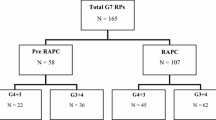Abstract
Background
In 2009, Rapid Access Prostate Cancer Clinics (RAPC) were introduced to St. James’s Hospital to improve the access and organisation of patients to prostate cancer investigations and treatment.
Aims
To observe the effects of the RAPC on prostate cancer diagnosis, primary treatment and overall workload.
Methods
Using a prospectively designed patient database, the records of all prostate cancer patients between 2007 and 2011 were retrieved and analysed. Data were obtained for age, PSA, biopsy Gleason score and primary treatment modality and charted for the observation and comparison of trends.
Results
Seven hundred and eighty-nine patients had a new diagnosis of prostate cancer between 2007 and 2011. The median PSA prior to the RAPC was 9.7–13.1 ng/ml, which decreased to 7.79–9 ng/ml after the RAPC. Prior to the RAPC, 77–81 biopsies were performed annually versus 149–271 in the post-RAPC era. Annual requirements for radical prostatectomy also increased from 12 to 27 in the post-RAPC era. Conversely, an initially increasing percentage of patients for radiotherapy was reversed in the post-RAPC period. An increasing trend for higher grade PCa (Gleason score 4 + 4 and higher) was also reversed.
Conclusions
The introduction of a RAPC improves the overall pathological characteristics of patients with prostate cancer. However, RAPCs are also associated with a considerable increase in surgical workload. These are important considerations for units considering the incorporation of a similar facility in their institutions.



Similar content being viewed by others
References
Ireland NCR (2006) Trends in Irish cancer incidence 1994–2002, with projections to 2020. http://www.ncri.ie/pubs/pubfiles/proj_2020.pdf
Ireland NCR (2010) Cancer trends. No. 3. Recent trends in prostate cancer. http://www.ncri.ie/pubs/pubfiles/prostatetrends.pdf
HSE (2012) National prostate cancer GP referral guidelines. http://www.hse.ie/eng/services/Find_a_Service/National_Cancer_Control_Programme/Health_Professional_Information/Prostate_Referral_Guideline.pdf
O’Kelly F, Thomas A, Murray D, Galvin D, Mulvin D, Quinlan DM (2013) Can delayed time to referral to a tertiary level urologist with an abnormal PSA level affect subsequent Gleason grade in the opportunistically screened population? Prostate. doi:10.1002/pros.22628
Children DoHa (2006) A strategy for cancer control in Ireland—National Cancer Forum 2006. Dublin
Forde JC, O’Connor KM, Casey L, O’Brien M, Bowen S, Casey RG, Ahmed I, McDermott TE, Grainger R, Lynch TH (2011) A rapid access diagnostic clinic for prostate cancer: the experience after one year. Ir J Med Sci 180(2):505–508. doi:10.1007/s11845-011-0695-3
O’Kelly F, Thomas AZ, Murray D, Lee P, O’Carroll RF, Nicholson P, Forristal H, Swan N, Galvin D, Mulvin D, Quinlan DM (2013) Emerging evidence for Gleason grade migration and distance impact in prostate cancer? An analysis of the rapid access prostate clinic in a tertiary referral center: St. Vincent’s University Hospital, Dublin (2009-2011). Ir J Med Sci 182(3):487–491. doi:10.1007/s11845-013-0920-3
Hankey BF, Feuer EJ, Clegg LX, Hayes RB, Legler JM, Prorok PC, Ries LA, Merrill RM, Kaplan RS (1999) Cancer surveillance series: interpreting trends in prostate cancer–part I: evidence of the effects of screening in recent prostate cancer incidence, mortality, and survival rates. J Natl Cancer Inst 91(12):1017–1024
Registry NC (2010) Cancer trends—Cancer of the prostate
Registry NC (2011) Cancer in Ireland 2011: Annual Report of the National Cancer Registry
Epstein JI, Allsbrook WC Jr, Amin MB, Egevad LL (2005) The 2005 International Society of Urological Pathology (ISUP) Consensus Conference on Gleason grading of prostatic carcinoma. Am J Surg Pathol 29(9):1228–1242
Epstein JI (2010) An update of the Gleason grading system. J Urol 183(2):433–440. doi:10.1016/j.juro.2009.10.046
Acknowledgments
The authors would like to acknowledge the St. James’s Hospital Urology Clinical Nurse Specialists Lynn Casey, Marion O’Brien, Sonya Bowen, Tanya Conroy, Angela Doyle as well as the St. James’s Hospital Cancer Audit Programme Manager Suzanne Rowley for their support in this publication.
Conflict of interest
None declared.
Author information
Authors and Affiliations
Corresponding author
Rights and permissions
About this article
Cite this article
Oon, S., Cullen, I., Moran, D. et al. The effect of a Rapid Access Prostate Cancer Clinic on prostate cancer patient and disease characteristics, primary treatment and surgical workload. Ir J Med Sci 183, 241–247 (2014). https://doi.org/10.1007/s11845-013-0997-8
Received:
Accepted:
Published:
Issue Date:
DOI: https://doi.org/10.1007/s11845-013-0997-8




